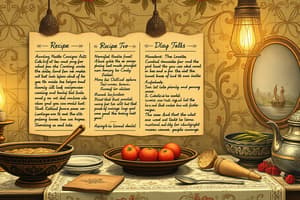Podcast
Questions and Answers
What is a characteristic of Recipe Writing?
What is a characteristic of Recipe Writing?
- Use of technical vocabulary
- Use of formal tone
- Use of imperative verbs (correct)
- Use of rhetorical questions
What is the purpose of Sequencing in procedure texts?
What is the purpose of Sequencing in procedure texts?
- To make the text more engaging
- To ensure clarity and coherence (correct)
- To provide additional information
- To add visual interest
What is a characteristic of Technical Writing?
What is a characteristic of Technical Writing?
- Use of rhetorical questions
- Use of humor
- Use of conversational tone
- Use of formal tone (correct)
What is a common feature of Instructional Writing?
What is a common feature of Instructional Writing?
What is the main difference between Recipe Writing and Instructional Writing?
What is the main difference between Recipe Writing and Instructional Writing?
What is a characteristic of Directions?
What is a characteristic of Directions?
What is the purpose of using transitional phrases in Sequencing?
What is the purpose of using transitional phrases in Sequencing?
What is a common feature of Technical Writing?
What is a common feature of Technical Writing?
What is the main purpose of Recipe Writing?
What is the main purpose of Recipe Writing?
What is a characteristic of Instructional Writing?
What is a characteristic of Instructional Writing?
Study Notes
Procedure Text
Recipe Writing
- A type of procedure text that provides instructions for preparing a dish
- Typically includes:
- Ingredients list
- Equipment needed
- Step-by-step instructions
- Cooking time and temperature
- Serving suggestions
- Characteristics:
- Clear and concise language
- Use of imperative verbs (e.g., "chop," "mix," "bake")
- Use of specific measurements and quantities
Instructional Writing
- A type of procedure text that provides instructions for completing a task or project
- Typically includes:
- Step-by-step instructions
- Materials needed
- Safety precautions
- Tips and variations
- Characteristics:
- Clear and concise language
- Use of imperative verbs (e.g., "assemble," "connect," "test")
- Use of diagrams and illustrations to support instructions
Technical Writing
- A type of procedure text that provides instructions for complex tasks or technical processes
- Typically includes:
- Detailed descriptions of procedures
- Technical specifications
- Safety protocols
- Troubleshooting guides
- Characteristics:
- Formal and objective tone
- Use of technical vocabulary and jargon
- Use of diagrams, flowcharts, and other visual aids
Sequencing
- The process of organizing steps in a logical and chronological order
- Importance:
- Ensures clarity and coherence
- Helps readers follow instructions
- Reduces errors and confusion
- Techniques:
- Numbering steps
- Using transitional phrases (e.g., "first," "next," "then")
- Breaking down complex tasks into smaller steps
Directions
- A type of procedure text that provides instructions for navigating a physical space or completing a task
- Typically includes:
- Clear and concise language
- Use of landmarks and reference points
- Step-by-step instructions
- Visual aids (e.g., maps, diagrams)
- Characteristics:
- Use of imperative verbs (e.g., "go," "turn," "follow")
- Use of specific directions (e.g., "north," "left," "up")
Recipe Writing
- Provides instructions for preparing a dish
- Includes ingredients list, equipment needed, step-by-step instructions, cooking time and temperature, and serving suggestions
- Uses clear and concise language, imperative verbs (e.g., "chop," "mix," "bake"), and specific measurements and quantities
Instructional Writing
- Provides instructions for completing a task or project
- Includes step-by-step instructions, materials needed, safety precautions, and tips and variations
- Uses clear and concise language, imperative verbs (e.g., "assemble," "connect," "test"), and diagrams and illustrations to support instructions
Technical Writing
- Provides instructions for complex tasks or technical processes
- Includes detailed descriptions of procedures, technical specifications, safety protocols, and troubleshooting guides
- Uses formal and objective tone, technical vocabulary and jargon, and diagrams, flowcharts, and other visual aids
Sequencing
- Organizes steps in a logical and chronological order
- Ensures clarity and coherence, helps readers follow instructions, and reduces errors and confusion
- Techniques include numbering steps, using transitional phrases (e.g., "first," "next," "then"), and breaking down complex tasks into smaller steps
Directions
- Provides instructions for navigating a physical space or completing a task
- Includes clear and concise language, use of landmarks and reference points, step-by-step instructions, and visual aids (e.g., maps, diagrams)
- Uses imperative verbs (e.g., "go," "turn," "follow") and specific directions (e.g., "north," "left," "up")
Studying That Suits You
Use AI to generate personalized quizzes and flashcards to suit your learning preferences.
Description
Understand the characteristics and components of procedure texts, including recipe writing and instructional writing, with a focus on language, structure, and formatting.




